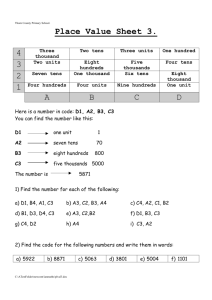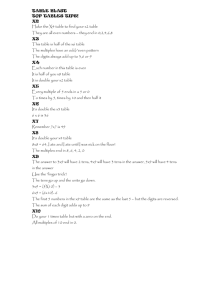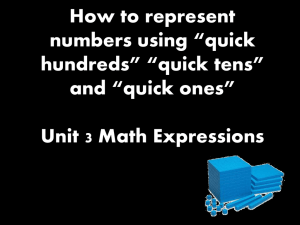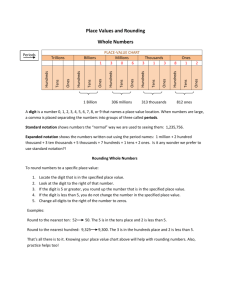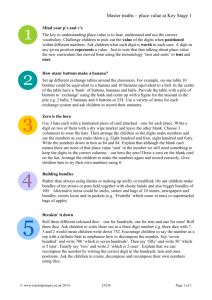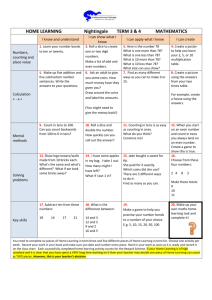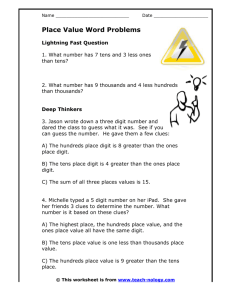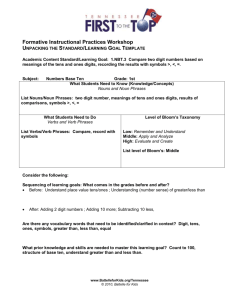- Educational Experience
advertisement
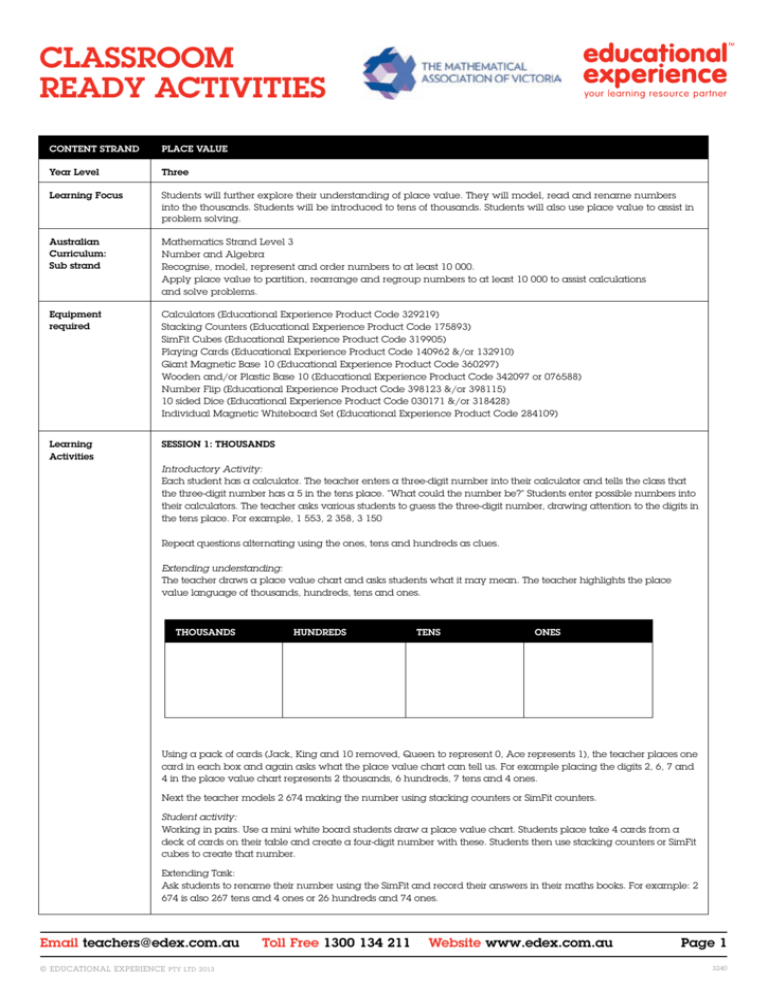
Classroom Ready Activities Content Strand Place Value Year Level Three Learning Focus Students will further explore their understanding of place value. They will model, read and rename numbers into the thousands. Students will be introduced to tens of thousands. Students will also use place value to assist in problem solving. Australian Curriculum: Sub strand Mathematics Strand Level 3 Number and Algebra Recognise, model, represent and order numbers to at least 10 000. Apply place value to partition, rearrange and regroup numbers to at least 10 000 to assist calculations and solve problems. Equipment required Calculators (Educational Experience Product Code 329219) Stacking Counters (Educational Experience Product Code 175893) SimFit Cubes (Educational Experience Product Code 319905) Playing Cards (Educational Experience Product Code 140962 &/or 132910) Giant Magnetic Base 10 (Educational Experience Product Code 360297) Wooden and/or Plastic Base 10 (Educational Experience Product Code 342097 or 076588) Number Flip (Educational Experience Product Code 398123 &/or 398115) 10 sided Dice (Educational Experience Product Code 030171 &/or 318428) Individual Magnetic Whiteboard Set (Educational Experience Product Code 284109) Learning Activities Session 1: Thousands Introductory Activity: Each student has a calculator. The teacher enters a three-digit number into their calculator and tells the class that the three-digit number has a 5 in the tens place. “What could the number be?” Students enter possible numbers into their calculators. The teacher asks various students to guess the three-digit number, drawing attention to the digits in the tens place. For example, 1 553, 2 358, 3 150 Repeat questions alternating using the ones, tens and hundreds as clues. Extending understanding: The teacher draws a place value chart and asks students what it may mean. The teacher highlights the place value language of thousands, hundreds, tens and ones. THOUSANDS HUNDREDS TENS ONES Using a pack of cards (Jack, King and 10 removed, Queen to represent 0, Ace represents 1), the teacher places one card in each box and again asks what the place value chart can tell us. For example placing the digits 2, 6, 7 and 4 in the place value chart represents 2 thousands, 6 hundreds, 7 tens and 4 ones. Next the teacher models 2 674 making the number using stacking counters or SimFit counters. Student activity: Working in pairs. Use a mini white board students draw a place value chart. Students place take 4 cards from a deck of cards on their table and create a four-digit number with these. Students then use stacking counters or SimFit cubes to create that number. Extending Task: Ask students to rename their number using the SimFit and record their answers in their maths books. For example: 2 674 is also 267 tens and 4 ones or 26 hundreds and 74 ones. Email teachers@edex.com.au © Educational Experience Pty Ltd 2013 Toll Free 1300 134 211 Website www.edex.com.au Page 1 3240 Classroom Ready Activities Content Strand Place Value Year Level Three Learning Activities Session 1: Thousands (CONTINUED) Concluding activity: The teacher selects a student to share one of the four-digit numbers they created. The student shares their work by saying “I made a four-digit number. It has a ? in the thousands place and ? in the hundred’s place and a ? in the ten’s place and ? in the one’s place. Who can name my number?” Assessment: Can students model and name a range of four-digit numbers? Session 2: Comparing thousands Introductory Activity: Students sit in partners and play the calculator place value game with each other (as in previous lesson). However this time students use four-digit numbers and play in partners instead of as a class. For example: I am a four-digit number and I have 6 tens. Extending understanding: The teacher draws the following diagram on the board. THOUSANDS HUNDREDS TENS ONES The teacher writes a four-digit number in the place value chart. The teacher selects students to make the number using giant magnetic base ten materials. The students should place the base ten materials into the place value chart putting them under the correct headings. This stays on the board and is then repeated. The teacher then asks which of the two numbers is larger and how do we know that? Student activity: Working in pairs. Each student rolls four ten sided dice. Using these numbers they make a four-digit number using a number flip board. Students make a model to match their number using base 10 materials. They compare with their partner who has the largest number. Students write the 2 four-digit numbers in their books and circle the largest number. Students may choose to alternate between making the smallest or largest number. Challenge: Once the students have played five rounds they try and order all of the ten numbers from smallest to largest. Concluding activity: The teacher holds out a bag with base 10 pieces in it and tells the class “I have some base 10 in my bag that makes the number 2 784. What pieces of base 10 should be in my bag?” Students identify the pieces needed. Assessment: Do students use place value language when identifying which number is larger or smaller? Can students order four-digit numbers? Email teachers@edex.com.au © Educational Experience Pty Ltd 2013 Toll Free 1300 134 211 Website www.edex.com.au Page 2 3240 Classroom Ready Activities Content Strand Place Value Year Level Three Learning Activities Session 3: Rearranging and re-organising thousands Concluding activity: The teacher places giant magnetic pieces in the correct values but places too many pieces in each column. Eg 12 tens in the tens column. THOUSANDS HUNDREDS TENS ONES Assessment: The teacher asks students if they can rename 12 tens. Extending understanding: The teacher elaborates that ten tens is one hundred and 12 tens is one hundred and two tens. The teacher then writes on the board a four-digit number eg 2 409 Together the class makes a list of the different ways we can rename this digit: 2 Thousands, 4 Hundreds, 0 Tens and 9 Ones 24 Hundreds, 0 Tens and 9 Ones 240 Tens and 9 Ones 2409 Ones Student activity: Students use dice to create a 3 or 4 digit number. They record their number in their book. Students then use base 10 pieces to model different ways to make the number. They record their responses in their book. Concluding Activity: The teacher holds out a bag with base 10 pieces in it and tells the class “I have some base 10 in my bag that makes the number 3 598. What pieces of base 10 should be in my bag?” Students identify the pieces needed. The teacher might ask, is there more than one answer? What might it be? Assessment: Can students rename a range of four-digit numbers? Can students read and make models of four-digit numbers with base ten materials? Session 4: Calculations and solving problems Introductory Activity: Play biggest number. The teacher rolls a ten-sided dice five dice. The students record the digits in a 5 digit place value chart as they are called out. The teacher also places the digits in a 5 digit place value chart. Note that there are different combinations and students may choose to make a different number to the teacher. The game ends after the dice has been rolled five times and the person with the largest 5 digit number is the winner. Did the students beat the teacher! Rotation Activity: Students are placed in mixed ability groups and complete the tasks allocated at four different stations. Rotation 1: Roll four ten sided dice. Record a four-digit number. How many ways can you rename your number? Rotation 2: Roll four ten sided dice. How many different four- digit numbers can you make using the digits the four digits that you rolled? Rotation 3: Play biggest number. Rotation 4: Students can complete a place value computer task. Concluding Activity: Choose one student from each group to share their responses with the class. Assessment: Can students rename a range of 4 digit numbers? Email teachers@edex.com.au © Educational Experience Pty Ltd 2013 Toll Free 1300 134 211 Website www.edex.com.au Page 3 3240


